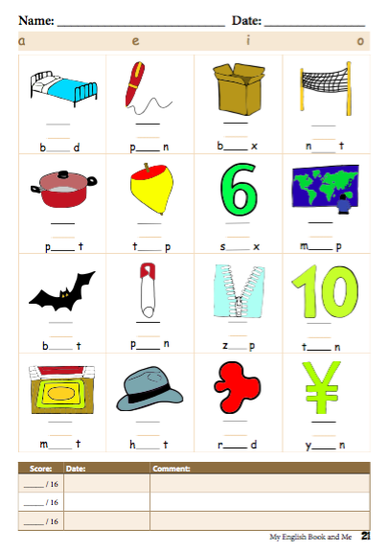
My English Book and Me 3 Classbook and Homebook are ABC phonics texts. Children will learn many new words
as they learn their phonics. There is constant review and re-enforcement with mini - tests. Students also learn conversational questions and answers.
We use MEB3 with ANY beginning elementary student (be they 5th graders or 1st graders). And with high
level kindergarten students who have finished My English Book and Me 1 and 2.
Why don’t ALL students begin with My English Book and Me 1? We feel it is important for elementary students to READ and WRITE ASAP.
Students who can READ can teach themselves. The lesson can progress from mainly teacher led to pair work. Children with similar reading abilities do activities where they READ
and find the answer: teaching themselves new vocabulary, grammar, questions and answers as they do so.
If phonics is SO important, why don’t kindergarten kids begin with My English Book and Me 3 also? Simply because children do not have the
pencil skills until the age of 5 or 6 to WRITE the phonics. BUT in MEB1 and 2, they can learn lots of new vocabulary, question and answers and recognize their phonics BEFORE writing.
They become confident, vocal students and are well prepared to begin writing in MEB3.
In our elementary (My English Book and Me 3, 4, 5, 6) lessons, we will do 40 minutes of activities in 3s or pairs (read ’n match, flip n’ read, question cards, flashcards….). These games and flashcards match the texts. But we find the
students reading level progresses faster than writing ability. So students will often do the games associated with My English Book and Me 4 even though their text is still My English Book
and Me 3.
In the 20 minute writing time, students:
1. Begin with the home book:
If a mini - test was assigned for homework, they will do the mini - test in class. (for homework, the student practiced in a notebook, not
writing in the text).
If previously done mini - tests had many mistakes, the teacher will erase the mistakes and the student will do the test a 2nd or 3rd time
(hopefully learning from mistakes and improving)
2. After reviewing the home book, the student will do the class book. The class book is similar to the home book.
Re-enforcing and reviewing.
3. Children work at THEIR pace. If they have many mistakes, they will do the mini - tests 2 or 3 times. If they have few or
no mistakes, only once.
4. Children should speak and write.
5. At the end of writing time, the teacher will assign 2 pages in the home book for homework and ready the pages for the following week
(folding down pages with many mistakes to be re-done the following week (and erasing the mistakes if time also).
We have translated HOW we use the texts and WHY into Japanese. We want our students’ parents to understand what we do and why. It
is essential for their children’s progress and for the success of our school.
How about your students? How about your school?

Write a comment